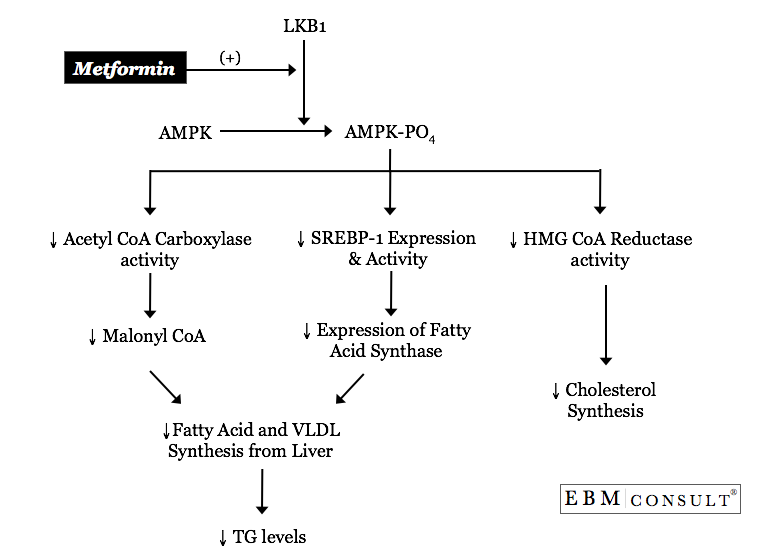It
is well known that patients with type 2 diabetes mellitus (T2DM) are characterized
as having central obesity (or increased abdominal visceral fat), hepatic
insulin resistance, decreased peripheral insulin mediated glucose uptake
(despite elevated insulin levels), excessive or accelerated "basal
rates" of hepatic glucose production (or hepatic gluconeogenesis), and
abnormal lipid profiles that are considered to be more "atherogenic".1-3
Unfortunately,
several glucose lowering agents (sulfonylureas, thiazolidinediones, and insulin
in particular) are also associated with an increase in weight - a problem
already implicated in T2DM. As it relates to cholesterol, many cases show
that an improvement in the glucose levels will improve the lipid profile
(generally through a reduction in very low density lipoprotein (VLDL) output from
the liver since it is directly tied to blood glucose levels).2-4 However,
not all glucose lowering medications have a beneficial and direct effect on the
lipid profile beyond their glucose lowering properties.2,4 Given the
characterization of most type 2 diabetics, any intervention that could not only
significantly improve glucose control, but that would also cause weight loss or
at least not weight gain, have a good history of safety, and improve the lipid
profile beyond the glucose lowering properties would be ideal.
Fortunately, metformin is the only cost-effective, oral glucose lowering agent
that meets all of these criteria.2,3,5-8
How
does metformin improve cholesterol levels beyond its glucose lowering
properties?
Metformin can activate an upstream primary kinase called LKB1.9 LKB1 then
phosphorylates and activates AMP-activated protein kinase (AMPK) which can then
affect the transcription (production) of several key regulators of liver lipid
production (lipogenesis) and hepatic gluconeogenesis.9,10 The first
regulation of lipogenesis is a reduction in the expression and activity of
sterol regulatory element binding protein-1 (SREBP-1) which leads to two
beneficial effects on lipids. One effect is a reduced expression of the
enzyme fatty acid synthase, which leads to a reduction in fatty acid
synthesis. These are both essential steps in the formation of
triacylglycerols (also known as triglycerides (TG)) that make up the majority
of VLDL being produced by the liver.10 Another effect is the phosphorylation
of 3-hydroxy-3-methyl-glutary;-CoA reductase (HMG CoA Reductase) which reduces
its cholesterol synthesis capabilities.3,11 The second regulation of
lipogenesis is a phosphorylation of acetyl CoA carboxylase thereby inhibiting
its activity. As a result, malonyl CoA levels are reduced leading to a
reduction in fatty acid synthesis (need for TG production) and an enhancement
of fatty acid oxidation.10

Therefore,
metformin improves the lipid profile beyond its glucose lowering effects by
reducing triglyceride and cholesterol synthesis. Metformin is known to
reduce triglycerides (TG) by about 10% and low density lipoprotein cholesterol (LDL-C)
by 10 to 15% and increase high density lipoprotein cholesterol (HDL-C) up to
7%.2,5,6,7,12,13 Given the level of difficulty in getting type 2
diabetics to their patient specific glucose and lipid goals, any additional
beneficial effect can be helpful, especially when further weight gain can be
avoided.
References:
- Monnier L, Colette C, Owens DR. Type 2 diabetes: a
well-characterised but suboptimally controlled disease. Can we bridge
the divide? Diabetes Metab 2008;34(3):207-16.
- DeFronzo RA. Pharmacologic therapy for type 2 diabetes mellitus. Ann Intern Med 1999;131(4):281-303.
- Leiberman M, Marks AD, eds. Mark's Basic Medical Biochemistry A Clinical Approach. 3rd Ed. Philadelphia, PA: Lippincott Williams & Wilkins; 2009:479-566.
- Jeppesen
J, Zhou MY, Chen YD et al. Effect of glipizide treatment on
postprandial lipaemia in patients with NIDDM. Diabetologia
1994;37(8):781-7.
- Bristol-Myers
Squibb Co. Glucophage (metformin hydrochloride) package insert.
Princeton, NJ; August 2008. Link obtained on 11/24/2008.
- DeFronzo
RA, Goodman AM. Efficacy of metformin in patients with
non-insulin-dependent diabetes mellitus. The Multicenter Metformin
Study Group. N Engl J Med 1995;333:541-9.
- Cusi
K, Consoli A, DeFronzo RA. Metabolic effects of metformin on glucose
and lactate metabolism in noninsulin-dependent diabetes mellitus. J
Clin Endocrinol Metab 1996;81:4059-4067.
- Nathan
DM, Buse JB, Davidson MB et al. Management of hyperglycemia in type 2
diabetes: a consensus algorithm for the initiation and adjustment of
therapy: a consensus statement from the American Diabetes Association
and the European Association for the Study of Diabetes. Diabetes Care
2009;32(1):193-203.
- Shaw
RJ, Lamia KA, Vasquez D et al. The kinase LKB1 mediates glucose
homeostasis in liver and therapeutics effects of metformin. Science
2005;310(5754):1642-1646.
- Zhou
G, Myers R, Li Y et al. Role of AMP-activated protein kinase in
mechanism of metformin action. J Clin Invest 2001;108:1167-1174.
- Clarke
PR, Hardie DG. Regulation of HMG-CoA reductase: identification of the
site phosphorylated by the AMP-activated protein kinase in vitro and in
intact rat liver. EMBO J 1990;9:2439-46.
- DeFronzo
RA, Barzilai N, Simonson DC. Mechanism of metformin action in obese
and lean noninsulin-dependent diabetics subjects. J Clin Endocrinol
Metab 1991;73(6):1294-301.
- Jeppesen
J, Zhou MY et al. Effect of metformin on postprandial lipemia in
patients with fairly to poorly controlled NIDDM. Diabetes Care
1994;17(10):1093-9.


